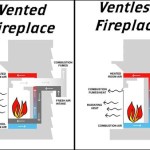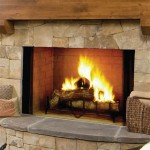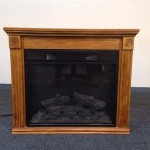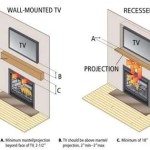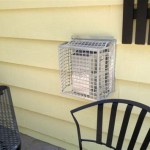Understanding and Using a Glass Door Fireplace
Glass door fireplaces offer a blend of aesthetics, efficiency, and safety compared to traditional open hearth fireplaces. They provide a clear view of the fire while simultaneously regulating airflow and preventing embers from escaping. This article serves as a comprehensive guide on understanding the components of a glass door fireplace and effectively using it for optimal performance and safety.
A glass door fireplace comprises several key components. The firebox is the primary area where the fire is built. The glass doors, typically made of tempered glass, enclose the firebox, controlling airflow and radiant heat. A mesh screen often sits behind the glass doors, providing an additional layer of safety when the doors are open. The damper, located within the chimney, regulates the airflow up the flue, controlling draft and preventing heat loss when the fireplace is not in use. Finally, an air intake system provides the necessary oxygen for combustion, either through vents in the firebox or from outside the house.
### Key Safety Precautions Before First UsePrior to using a glass door fireplace for the first time, a thorough inspection is crucial to ensure safe and efficient operation. The first step involves checking the chimney for obstructions. Birds' nests, leaves, or other debris can block the flue, leading to smoke buildup inside the house and potentially causing a fire hazard. A professional chimney sweep can perform a comprehensive inspection and cleaning to eliminate any blockages.
Next, the glass doors themselves should be examined for cracks or damage. Damaged glass can compromise the structural integrity of the doors and pose a safety risk. If any cracks are present, the glass should be replaced by a qualified technician before using the fireplace. It is also important to ensure that the doors close properly and form a tight seal, preventing smoke from escaping into the room.
The damper mechanism needs to be inspected to verify that it opens and closes smoothly. A stuck or damaged damper can impede airflow, leading to inefficient burning and potential smoke problems. Lubricating the damper mechanism with a heat-resistant lubricant can help ensure smooth operation. If the damper is severely damaged, it may require replacement.
Finally, a functional carbon monoxide detector is an essential safety device for any home with a fireplace. Carbon monoxide is a colorless, odorless, and toxic gas that can be produced by incomplete combustion. The detector should be placed near the fireplace and tested regularly to ensure it is working correctly. Replacing the batteries at least twice a year is recommended.
### Preparing the Fire and Managing AirflowPreparing the fire correctly is essential for efficient burning and minimizing smoke. The foundation of the fire should be a layer of kindling, consisting of small, dry twigs or wood shavings. This kindling provides a readily combustible fuel source to ignite the larger pieces of wood. Avoid using paper as kindling, as it can produce excessive ash and contribute to chimney buildup.
Next, add a layer of small, dry logs on top of the kindling. These logs should be arranged in a crisscross pattern to allow for ample airflow around the wood. The air gaps between the logs facilitate combustion and promote a cleaner burn. Hardwoods like oak, maple, and birch are preferred for firewood because they burn longer and produce more heat than softwoods like pine.
The positioning of the logs relative to the air intake vents is crucial. Ensure that the logs do not obstruct the vents, as this can restrict airflow and lead to incomplete combustion. Proper airflow is necessary to maintain a hot and efficient fire. As the fire burns, add larger logs to maintain the heat output. Avoid overloading the firebox with too much wood, as this can also restrict airflow and lead to smoking.
Managing airflow is critical for controlling the burn rate and heat output of the fireplace. Opening the damper fully allows for maximum airflow, resulting in a hotter and faster-burning fire. Closing the damper partially restricts airflow, slowing down the burn rate and reducing heat output. Experimenting with different damper settings allows for fine-tuning the fire to achieve the desired heat level.
The glass doors also play a role in airflow management. When the doors are closed, the airflow is primarily controlled by the air intake vents. Opening the doors slightly can increase airflow and create a hotter fire, but this also increases the risk of embers escaping. It is important to exercise caution when operating the fireplace with the doors open.
### Maintenance and Cleaning ProceduresRegular maintenance and cleaning are essential for ensuring the safe and efficient operation of a glass door fireplace. The glass doors themselves require periodic cleaning to remove soot and creosote buildup. Using a commercial fireplace glass cleaner is recommended, as these cleaners are specifically designed to remove stubborn deposits without damaging the glass. Avoid using abrasive cleaners, as they can scratch the glass surface.
The frequency of cleaning depends on how often the fireplace is used and the type of wood burned. As a general rule, the glass doors should be cleaned at least once a month during the heating season. More frequent cleaning may be necessary if burning softwoods, which tend to produce more soot. Before cleaning the glass, allow the fireplace to cool completely.
The firebox also requires periodic cleaning to remove ash and debris. Ash can accumulate quickly, and excessive buildup can reduce the firebox's capacity and interfere with airflow. Use a shovel and brush to remove the ash and dispose of it properly in a metal container. Never dispose of hot ashes in a plastic container or near flammable materials.
The chimney should be inspected and cleaned annually by a qualified chimney sweep. Creosote, a flammable byproduct of combustion, can accumulate in the chimney and pose a significant fire hazard. Regular chimney cleaning removes creosote buildup and helps prevent chimney fires. The chimney sweep will also inspect the chimney for any structural damage or other potential problems.
The gasket around the glass doors should also be inspected periodically. A worn or damaged gasket can allow air to leak into the firebox, reducing the efficiency of the fireplace. Replacing the gasket is a relatively simple task that can improve the fireplace's performance. Purchase a replacement gasket that is specifically designed for your fireplace model and follow the manufacturer's instructions for installation.
Finally, inspect the firebox for any cracks or damage. Cracks can compromise the structural integrity of the firebox and pose a safety risk. If any cracks are present, they should be repaired by a qualified technician. Minor cracks can often be repaired with refractory cement, while larger cracks may require more extensive repairs or even replacement of the firebox.

Fireplace Glass Doors Vs Screens Full Service Chimney

Glass Fireplace Doors Pro Tips On How To Install Them

Why You Need Glass Doors On Your Fireplace

Fireplace Glass Doors Vs Screens Full Service Chimney

Why Should I Get A Glass Fireplace Door Installed On My

Fireplace Glass Doors Vs Screens Full Service Chimney

Glass Fireplace Doors

Fireplace Doors The Complete Glass Door Guide

Fireplace Doors The Complete Glass Door Guide

The Value Of Glass Doors For Your Fireplace Royal Oak Mi
Related Posts

